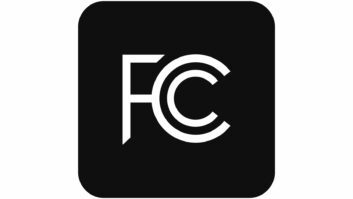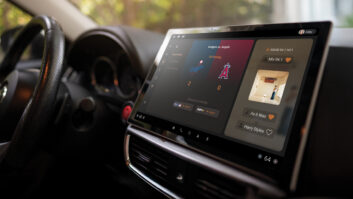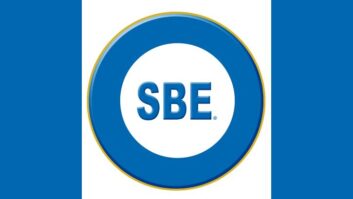The 2015 NAB Show has been over for a couple of months now but there’s still chatter about things we had seen and read during the show. Themes of consolidation and efficiency seemed to pop out of the radio hall.

When in Vegas for the NAB Show… Tech editor Rich Rarey (right)
made time for a signature cut and style from barber Neil Scartozzi,
owner of the Celebrity Club Barber Salon. After 40+ years
at the Riviera, the salon closed its doors in April due to the hotel being demolished to make way for more convention space. For instance ENCO’s enStreamer content distribution device was a complete charmer; it’s based on the Raspberry Pi platform. The Raspberry Pi — you may already own one — is a $35, full-blown computer based on the Broadcom BCM2836 system on a chip. The computer can be booted from a choice of several flavors of Linux, or a RISC operating system, or an open source media centre, or eventually Windows 10. It was designed and built in the U.K. by the nonprofit Raspberry Pi foundation. The foundation’s stated goal is to advance the education of adults and children in computing, computer science and related subjects.
That the foundation designed and built a wonderfully robust, flexible, affordable computer is marvelous. That Raspberry Pi users formed an extensive open society helping each other with RasPi projects is remarkable. But I never expected to see a Raspberry Pi as the basis of a professional broadcast product at the 2015 NAB Show. I thought it was too early to see the Raspberry Pi platform appear in the broadcast arena, but its embodiment of efficiency makes complete sense here. So dust off your C, C++, Java, BASH and Python programming books, and expect more Raspberry Pi computers in our broadcast workplace.
The GatesAir Flexiva FLX series liquid-cooled HD Radio transmitter was exciting because we haven’t seen water and RF energy in the same domestically manufactured radio cabinet since WLW’s 1928 Western Electric model A-7 transmitter. In the 21st century, the FLX coolant uses a 50/50 paring of either propylene or ethylene glycol (antifreeze) and distilled water. GatesAir said a transmitting plant’s air conditioning tonnage could be reduced by nearly 90 percent of that needed for comparable air-cooled transmitter, which, they pointed out, saves energy costs and attendant HVAC maintenance costs.
For efficient consolidation, the Nautel proof-of-concept HD Multiplex technology was remarkable; who knew one could broadcast three more independent, all-digital HD Radio stations (15 audio streams) from a single transmitter and antenna? Nautel’s Philipp Schmid and Brian Walker and their team created a futuristic, practical demonstration comparable in significance, I believe, to Edwin H. Armstrong’s 1949 FM Multiplex system or John H. Bose’s 1953 FM Multiplex receiver.
That’s just a sampling; to learn about those and a lot more, watch Radio World’s post-NAB Show webinar on demand at www.radioworld.com/webinar-archive.
AND NOW OUR FEATURE PRESENTATION
In this edition of RWEE, we present in its entirety the NAB Labs All-digital AM Test Project report that studied the feasibility of an all-digital AM service. I have wanted to publish the whole of this study to put the report into your hands for your evaluation ever since David Layer, the author, gave a presentation to a local SBE chapter meeting last year. That presentation was replete with compelling audio clips of a nighttime all-digital broadcast received hundreds of miles away. Although the study had been in motion since 2012, hearing that clean, faraway radio signal last year made it real.

Until this report was released at the 2015 show, it seemed that much emotion swirled around the technical and economic future of AM broadcasting. This report brings science and methodology to the discussion, notes some hopeful points and some cautions in its evaluations, and openly calls for additional research to answer questions not covered in this study. Studies like this NAB Labs report tends to calm emotions and increase clarity of thinking from all perspectives.
The study was prompted by some AM broadcasters’ interest to leap-frog over the lukewarm acceptance of the AM digital hybrid system and go straight to an all-digital AM path; however there was a lack of readily available technical information on the performance and capability of the all-digital AM service, other than that in the NRSC-5 Standard and Reference Documents (that NRSC-5-C document is freely available at nrscstandards.org).
BRIEF HIGHLIGHTS
The elegance of the NAB Labs study is the detail with which the field test plan was developed: A variety of categories were defined that brought into the study Class A, C and D stations; non-directional and directional stations; stations with a complex antenna array; and a category intriguingly called “Challenging facility” where an analog-only AM station licensed in 1947, still with some original transmission equipment, was outfitted with modern HD Radio transmission equipment. This category studied how the station’s all-digital signal affected its analog co-channel neighbors and the complexity of converting an analog-only AM station to an all-digital AM station.
A number of popular Ford vehicles were rented in each station’s area for gathering reception data while driving pre-defined road routes. These driving reception tests were realistic by virtue of employing the vehicle’s OEM radio and antenna rather than a specialized HD Radio Reference receiver. The audio of the OEM in-dash receiver (using the vehicle’s built in antenna) was fed into laptop software developed by iBiquity Digital Corp. that determined if the vehicle’s receiver was acquiring the digital audio signal.
A thoughtful aspect to these driving tests was mentioned in the report: Since there was no fallback analog signal coming from the station, a simple technique was devised to determine if the audio was merely silent (“dead air”), or if the digital signal had been lost and the receiver output was muted. The technique was to add a low-level 25 Hz tone to the audio transmitted by the station. The laptop software keyed on the presence or absence of the 25 Hz tone (No 25 Hz tone = No digital reception).
The report also describes the radio test bed NAB Labs constructed to perform co-channel and adjacent-channel interference testing using five off-the-shelf HD Radio receivers. These tests had to be conducted under controlled laboratory conditions because the “numerous and uncontrollable variables” that exist in a field interference test affect the accuracy of the measurements. Interestingly, iBiquity’s exhaustive tests made prior to the FCC’s authorization of AM hybrid mode are considered to represent “worst-case” adjacent-channel interference conditions because the hybrid mode uses a bandwidth of ±15 kHz, and no additional adjacent-channel studies are believed to be needed. An all-digital AM transmission uses either ±5 kHz or ±10 kHz bandwidth.
The study is well written, easy to understand and, I hope, will be useful to you.
Comment on this or any story. Write to [email protected].







